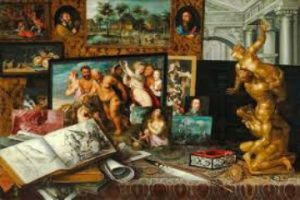All of us have a collection of sorts over the years. As a young child, you likely have collected various knick knacks that you found nice and fancy enough to show off to your friends. And your collection often reflects your interests during those periods of growing up. These collections may be considered as rubbish by others because most of them often lack in monetary value. However, they are the beginning of an obsession that the person will carry in his lifetime.
 Among the most sought after is an art collection. This is an expensive and classy collection you can be proud of and even pass on to your children. Their value increases over time which makes owning one even better. Regardless of the style you like, there is something that will appeal to your senses and earn your thumbs up.
Among the most sought after is an art collection. This is an expensive and classy collection you can be proud of and even pass on to your children. Their value increases over time which makes owning one even better. Regardless of the style you like, there is something that will appeal to your senses and earn your thumbs up.
Every company wants to stand out in their industry. To make your company an original, you need to apply some artistic creativity to the decisions you make. The simplest way to tap into that innovative spirit may be to start learning about and collecting art. Although more and more tech moguls are breaking into the art-collecting world, that doesn’t mean it’s confined to the elite.
Even young entrepreneurs can get into the game if they play it right. In the 1960s, Herb and Dorothy Vogel, a postal service worker and a librarian, began collecting minimal and conceptual art. Despite financial limitations, they allotted a certain percentage of their salary to buying art. Over time, they collected more than 4,000 works of art, which could’ve netted the couple millions of dollars if that was their interest. Instead, the Vogels donated their collection to 50 institutions across 50 states.
The process of creating your art collection is an art form in its own right. When you’re passionate about the arts, you can commit to the long journey of collecting without worrying about what you’ll get out of it. And by supporting art institutions and artists, both you and your company can experience a wide range of benefits.
(Via: https://www.entrepreneur.com/article/242588)
Art collections are such eye candies. You can spend a great deal of time immersed in each painting and witness how talent comes to life. But while we try to look at art and art collections as an artistic expression, we can’t help but notice that many art pieces also have political meanings.
Art has always been political, because art is part of the culture. Culture is based on shared values, and those are the result of group decisions. Group decision-making is the definition of politics.
Additionally, because patrons are important for artists, art has always commented on wealth or influence. Whether praising it, or critiquing it, art is inherently concerned with power. At its best, this includes patrons like the Medicis of Florence backing the works of the Renaissance giants. In our own era, this usually takes the form of the public funding creative work through direct purchase. When we buy a ticket to a Scorsese movie, we don’t think of ourselves as playing the role of a Rockefeller funding a filmmaker, but in effect, that’s what we’re doing. Bernini had Pope Urban VIII as his patron; The Pixies had the American consumer.
And we Americans are lucky enough to be the cradle of such a grand display of talent. The question now is, do the arts get the support it needs?
Nowhere is power and influence so concentrated as in New York City, and, unsurprisingly, the world of art resides there as well. It would be interesting to draw a map of the creative ley lines running between Manhattan, home of private art grants, and Washington, D.C., home of government art grants. Indeed, it is within these two cities that our story lies.
(Via: https://www.pastemagazine.com/articles/2017/01/podesta.html)
We can’t help but inject some political tone here because the culture and the arts are under some major political attack in the form of budget cuts.
As the Trump administration releases its first federal budget plan, it’s clear that weapons companies and wall builders make out spectacularly. While they plan to increase defense spending, pave a way for the border wall and increase school vouchers, everything else of importance to the American people gets cut or eliminated—like job training programs for seniors and disadvantaged youth, Meals on Wheels and medical research, and the Corporation for Public Broadcasting (which provides revenue for PBS and National Public Radio) just to name a few.
Other programs proposed for elimination are the National Endowment for the Arts and the National Endowment for the Humanities. Because who needs any kind of culture anyway, right?
President Trump is probably one of the biggest hurdles the world of the arts (in America) has ever faced in recent years. The threat is real and people’s lives will be affected by this lack of funding. President Trump does not consider the arts as important as national defense, hence it is one of the first ones to go in his administration. A country devoid of the arts lacks an identity that a certain place exudes. Only a miracle can save the industry from the challenges it is now facing.
The following blog post Art Collections No More Read more on: https://www.iamnotanartist.org
source https://www.iamnotanartist.org/art-collections-no-more/

No comments:
Post a Comment